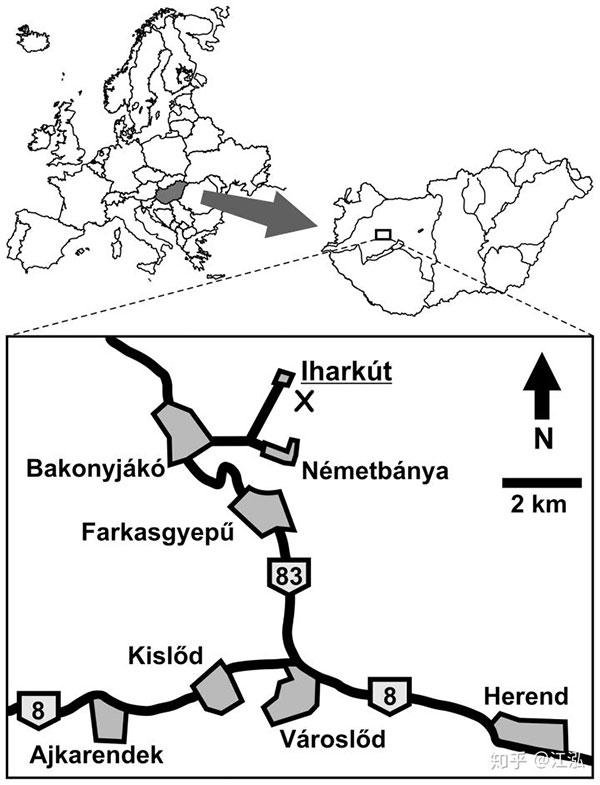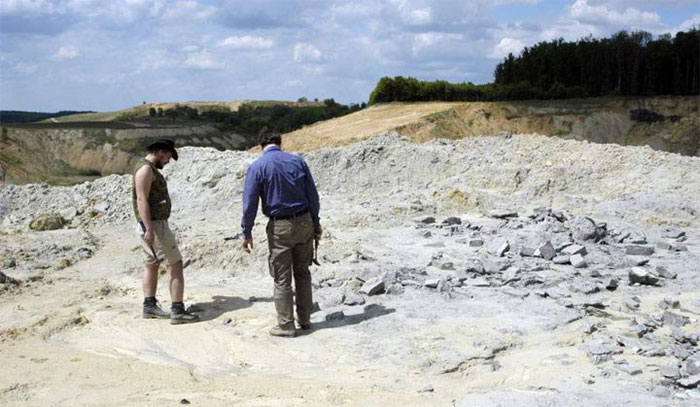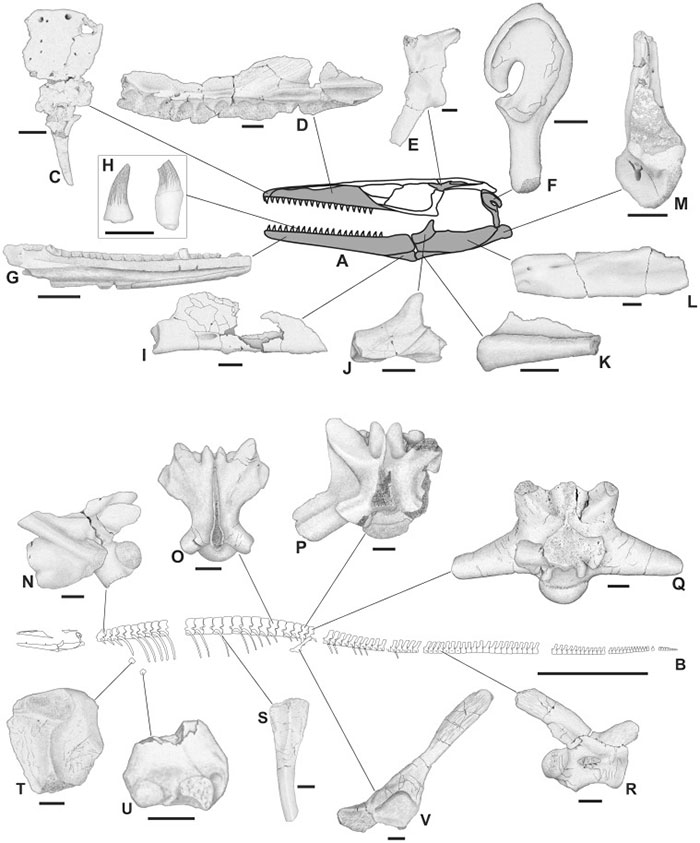Pannoniasaurus: The monster is 6 meters long in the fresh water of Hungary
Pannoniasaurus is a relative and smaller version of the famous aquatic monster Mosasaurus. They are famous for being the first known species of Mosasaur to live in freshwater habitats.
Hungary is located in the interior of Europe. Legend has it that many monsters live here. Although the authenticity of legendary monsters cannot be confirmed, through fossils excavated here, we learn that during the Cretaceous period more than 80 million years ago, a Mosasaurus (a genus of lizard, an extinct group of aquatic lizards that lived during the Late Cretaceous Maastricht, dating from 70 to 66 million years ago, in Western Europe and North America). ) with a length of 6 meters does exist in rivers and lakes of Hungary.
In Hungary, fossils of paleontological species can often be found in coal mines, and this time is no exception. In 1999, paleontologists of the Hungarian Natural History Museum found fossils lying under a reservoir of waste from a coal mine in western Hungary dating to 84 million years from the Csehbanya Formation. Formation.
After analysis, paleontologists discovered that these fossils belong to the Meuse lizard family, a genus dragon, but through the geological layer, paleontologists confirmed that this was a species. The dragon is completely new and they live in fresh water instead of the sea like their relatives.

The location of the fossil of Pannoniasaurus.

Where to find fossils.
In December 2012, after in-depth study of the fossils discovered, paleontologists published a study entitled "The first Meuse river lizard of the Cretaceous period at Hungary, " in the paper, paleontologists have named their name Pannoniasaurus.

Fossils of Pannoniasaurus.
The name Pannoniasaurus includes "Pannonia" , this is the name of a Roman province, including part of present-day Hungary, where fossils and "saurus" were discovered in Latin meaning lizards, and their scientific name of consciousness is Pannoniasaurus cheapectatus.

They have an average length of 1 to 4 meters and are all immature individuals.
The fossils found in a coal waste reservoir in western Hungary belong to many Pannoniasaurus, not one, they have an average length of 1 to 4 meters and are all immature individuals. Fort. After calculations, paleontologists said they can reach a length of 6 meters in adulthood. After simulating their bodies, it can be seen that these long dragons have quite thin and long bodies, especially they are much thinner than those in the ocean.

They live in fresh water most of the time, but when the water is shallow or when they need to move from one river to another, they have to climb ashore like no other crocodile. Pannoniasaurus teeth are relatively small and sharp, a sign that they only eat fish. In addition, they may also eat amphibians and lizards.
Pannoniasaurus possesses a skull (about 0.5 meters) long, whose mouth is covered with many sharp teeth - this is also their hunting weapon.
In addition, they also possess a short neck, a long body, a slender tail at the back and may have a caudal fin at the end. The two pairs of fins on the front and back of the body of Pannoniasaurus differ from the paddle-shaped fins of sea lizards.
Instead, the fins are shaped quite similar to the limbs and have claws connected to each other through the membrane between the toes. Because the number of fossils discovered is still very limited, the actual shape of their limbs so far is only a guess.


This species has a length of about 6 meters and weighs over 100kg, has a flat skull like a crocodile. Their four limbs are shaped more like legs than fins, so researchers say they often climb ashore and are one of the oldest Mosasaur species because the limbs have not fully evolved into the fins.
Through carbon dating analysis, paleontologists confirmed that the Pannoniasaurus lived in Late Cretaceous from 85 to 83 million years ago, when Europe was still divided by rising sea levels.
Fossils of Pannoniasaurus come from Csehbánya Formation Formation. Fossils of fish, amphibians, reptiles and crocodiles are also found in this stratigraphy and show that this area was once a freshwater habitat.
In addition, in the Csehbánya Formation Formation, many fossil samples from species such as Ajkaceratops, Hungarosaurus, Mochlodon, Pneumatoraptor, Bakonydraco were discovered.
Paleontologists believe that Pannoniasaurus was one of the leading predators in the freshwater environment of their time. According to an analysis of the skull and teeth structure, paleontologists believe that their main food is fish and amphibians in the water, and sometimes they also attack lizards and terrorists. sometimes near the environment in which they live.
Unlike the vast majority of dragons, scholars believe that Pannoniasaurus possesses paws-like fins and can help them climb the land to move instead of living their whole life underwater like their relatives. mine.

Their main food is fish.
Today, we know that the ancestors of the long-necked dragons are terrestrial lizards like whales whose ancestors lived on land and gradually transformed into aquatic life along with the geographical environment. of Europe at that time divided by the ocean, many paleontologists questioned whether Pannoniasaurus evolved to adapt from saltwater to freshwater habitats.
It is hypothesized that this species belongs to the Tethysaurinae family and is a fairly primitive river lizard and it is likely that they lived in freshwater habitats in the first place instead of being transformed from salt water to fresh water.
If this is true then this could prove that Pannoniasaurus has evolved independently and is different from most other species of leprechaun living in the ocean.
However, there is another theory that these Pannoniasaurus individuals were found in freshwater habitats at the time they died, which does not necessarily mean that they lived in freshwater habitats.
In fact, like saltwater crocodiles and bull sharks, they may occasionally be attracted to the smell of the dead body of a dinosaur upstream, or perhaps be swept into a river. somehow by a big storm that can't come back to the sea.
And perhaps the correct answer will still take a long time to figure out.

- Freshwater monsters in Europe
- 8th graders make devices that turn seawater into fresh water
- Create fresh water with solar energy
- The zipper bag has a capacity of 2,000 cubic meters of water
- The secret to keeping fresh flowers long during Tet holidays
- How to keep fresh gladiolus flowers long during Tet holidays
- Surely the giant sea monster swam under the water, marveling at the truth
- 50% of the world's population lacks fresh water by 2050
- 10 most famous aquatic monsters of all time
- The 'fresh water monster' species makes swimmers run away from slippers
- Legend of the 'water monster' Da river
- The breakthrough solution helps preserve fresh milk up to 60 days
 Discovered an ancient centipede fossil 99 million years old
Discovered an ancient centipede fossil 99 million years old Discovered bat-like dinosaurs in China
Discovered bat-like dinosaurs in China Discovered a 200-year-old bronze cannon of the coast
Discovered a 200-year-old bronze cannon of the coast Discover 305 million-year-old spider fossils
Discover 305 million-year-old spider fossils Freshwater monsters in Europe
Freshwater monsters in Europe 